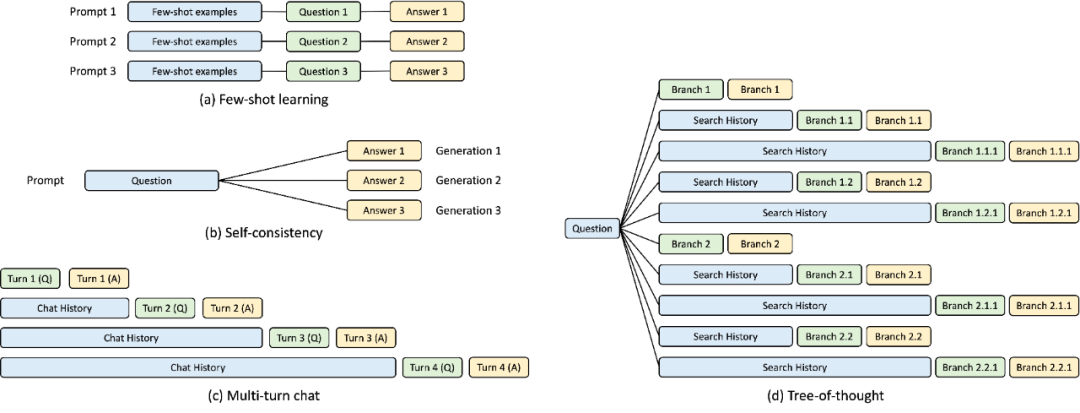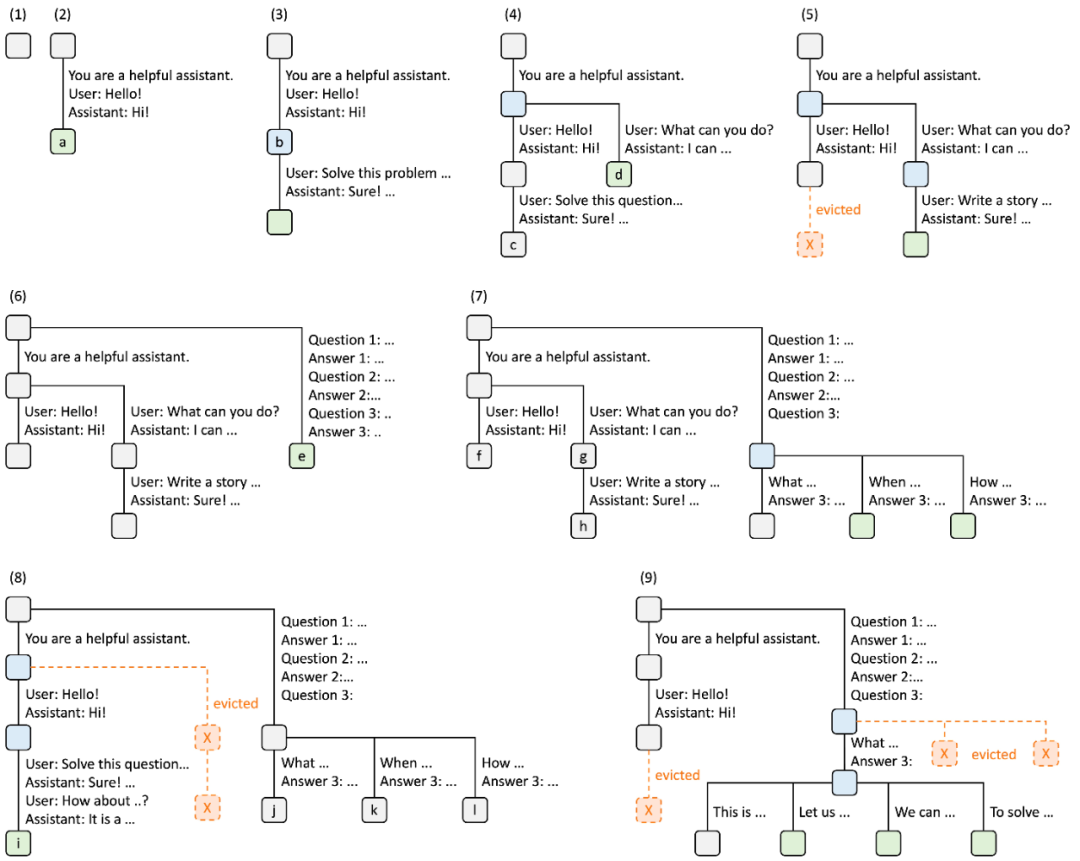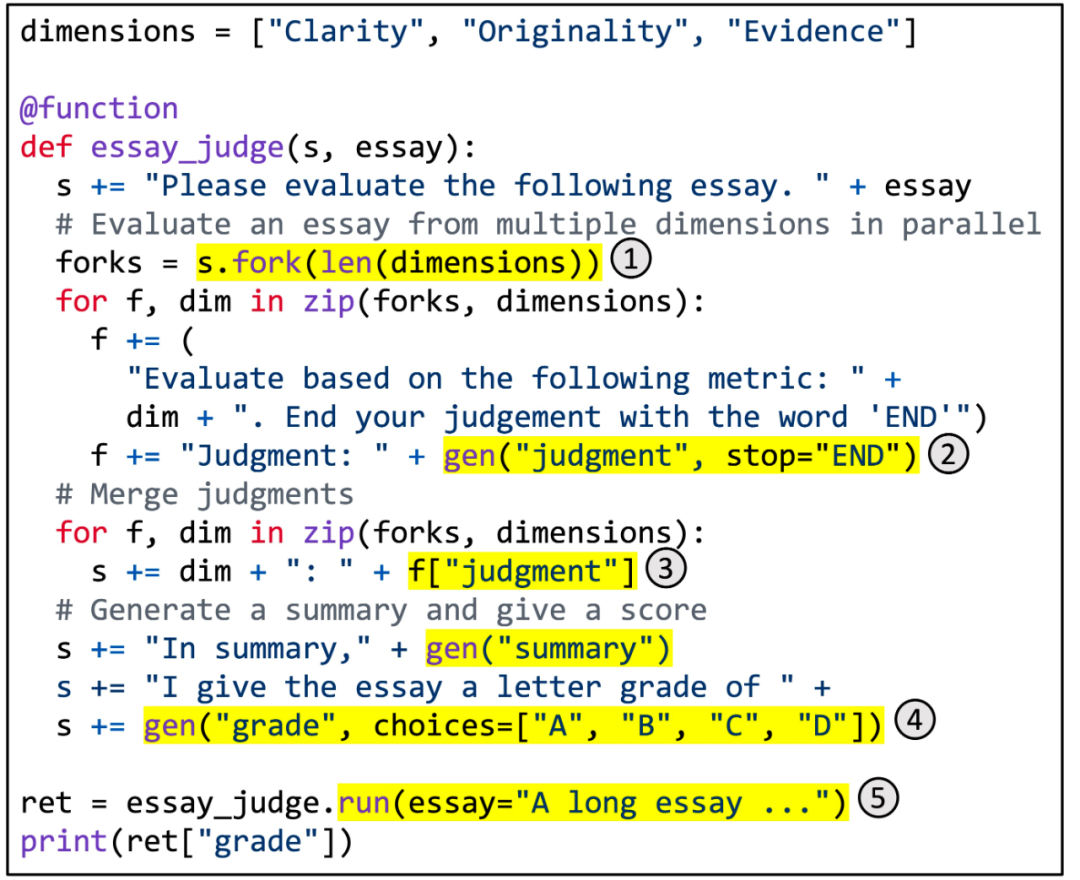 Technology peripherals
Technology peripherals
 AI
AI
 The throughput is increased by 5 times. The LLM interface for jointly designing the back-end system and front-end language is here.
The throughput is increased by 5 times. The LLM interface for jointly designing the back-end system and front-end language is here.
The throughput is increased by 5 times. The LLM interface for jointly designing the back-end system and front-end language is here.
Large language models (LLMs) are widely used in complex tasks that require multiple chained generation calls, advanced hinting techniques, control flow, and interaction with the external environment. Despite this, current efficient systems for programming and executing these applications have significant shortcomings.
Researchers recently proposed a new Structured Generation Language (Structured Generation Language) called SGLang, which aims to improve interactivity with LLM. By integrating the design of the back-end runtime system and the front-end language, SGLang makes LLM more performant and easier to control. This research was also forwarded by Chen Tianqi, a well-known scholar in the field of machine learning and CMU assistant professor.

In general, SGLang’s contributions mainly include:
In the back end, the research team proposed RadixAttention, which is A KV cache (KV cache) reuse technology across multiple LLM generation calls, automatic and efficient.
In front-end development, the team developed a flexible domain-specific language that can be embedded in Python to control the generation process. This language can be executed in interpreter mode or compiler mode.
The back-end and front-end components work together to improve the execution and programming efficiency of complex LLM programs.
This study uses SGLang to implement common LLM workloads, including agent, inference, extraction, dialogue, and few-shot learning tasks, and adopts Llama-7B and Mixtral-8x7B models on NVIDIA A10G GPUs. As shown in Figure 1 and Figure 2 below, SGLang’s throughput is increased by 5 times compared to existing systems (i.e., Guidance and vLLM).

Figure 1: Throughput of different systems on LLM tasks (A10G, Llama-7B on FP16, tensor parallelism = 1)

Figure 2: Throughput of different systems on LLM tasks (Mixtral-8x7B on A10G, FP16, Zhang Amount of parallelism = 8)
Backend: Use RadixAttention for automatic KV cache reuse
During the development process of SGLang runtime, the The study found that the key to optimizing complex LLM programs is KV cache reuse, which the current system does not handle well. KV cache reuse means that different prompts with the same prefix can share the intermediate KV cache, avoiding redundant memory and calculations. In complex programs involving multiple LLM calls, various modes of KV cache reuse may exist. Figure 3 below illustrates four such patterns commonly found in LLM workloads. While some systems are able to handle KV cache reuse in certain scenarios, manual configuration and ad hoc adjustments are often required. Furthermore, due to the diversity of possible reuse patterns, existing systems cannot automatically adapt to all scenarios even through manual configuration.

#Figure 3: KV cache sharing example. The blue box is the shareable prompt part, the green box is the non-shareable part, and the yellow box is the non-shareable model output. Shareable parts include small-shot learning examples, self-consistency questions, conversation history across multiple rounds of dialogue, and search history in tree-of-thought.
To systematically exploit these reuse opportunities, this research proposes a new method for automatic KV cache reuse at runtime - RadixAttention. Instead of discarding the KV cache after completing the build request, this method keeps the prompt and KV cache of the build result in a radix tree. This data structure enables efficient prefix searches, insertions, and evictions. This study implements a least recently used (LRU) eviction policy, supplemented by a cache-aware scheduling policy to improve the cache hit rate.
A radix tree can be used as a space-saving alternative to a trie (prefix tree). Unlike typical trees, the edges of radix trees can be marked not only with a single element, but also with sequences of elements of different lengths, which improves the efficiency of radix trees.
This research utilizes a radix tree to manage the mapping between token sequences acting as keys and corresponding KV cache tensors acting as values. These KV cache tensors are stored on the GPU in a paged layout, where each page is the size of a token.
Considering that the GPU memory capacity is limited and unlimited KV cache tensors cannot be retrained, an eviction strategy is required. This study adopts the LRU eviction strategy to evict leaf nodes recursively. Additionally, RadixAttention is compatible with existing technologies such as continuous batching and paged attention. For multi-modal models, RadixAttention can be easily extended to handle image tokens.
The diagram below illustrates how a radix tree is maintained when handling multiple incoming requests. The front end always sends the complete prompt to the runtime, and the runtime automatically performs prefix matching, reuse, and caching. The tree structure is stored on the CPU and has low maintenance overhead.

Figure 4. Example of RadixAttention operation using LRU eviction policy, illustrated in nine steps.
Figure 4 demonstrates the dynamic evolution of the radix tree in response to various requests. These requests include two chat sessions, a batch of few-shot learning queries, and self-consistent sampling. Each tree edge has a label representing a substring or sequence of tokens. Nodes are color-coded to reflect different states: green indicates newly added nodes, blue indicates cached nodes that were accessed at that point in time, and red indicates nodes that have been evicted.
Front End: LLM Programming Made Easy with SGLang
On the front end, the study proposes SGLang, a domain-specific language embedded in Python that allows expression Advanced prompt techniques, control flow, multimodality, decoding constraints and external interactions. SGLang functions can be run through various backends such as OpenAI, Anthropic, Gemini, and native models.

Figure 5. Using SGLang to implement multi-dimensional article scoring.
Figure 5 shows a specific example. It utilizes branch-resolve-merge prompt technology to achieve multi-dimensional article scoring. This function uses LLM to assess the quality of an article along multiple dimensions, combine judgments, generate a summary, and assign a final grade. The highlighted area illustrates the use of the SGLang API. (1) fork creates multiple parallel copies of prompt. (2) gen calls LLM generation and stores the results in variables. This call is non-blocking, so it allows multiple build calls to run simultaneously in the background. (3) [variable_name] retrieves the generated results. (4) Choose to impose constraints on the generation. (5) run executes the SGLang function using its parameters.
Given such an SGLang program, we can either execute it through the interpreter or trace it as a data flow graph and run it using a graph executor. The latter case opens up space for some potential compiler optimizations, such as code movement, instruction selection, and automatic tuning.
SGLang's syntax is heavily inspired by Guidance and introduces new primitives, also handling in-procedural parallelism and batch processing. All these new features contribute to SGLang's excellent performance.
Benchmarking
The research team tested its system on common LLM workloads and reported the achieved throughput.
Specifically, the study tested Llama-7B on 1 NVIDIA A10G GPU (24GB) and Mixtral-8x7B on 8 NVIDIA A10G GPUs with tensor parallelism using FP16 accuracy. And use vllm v0.2.5, guidance v0.1.8 and Hugging Face TGI v1.3.0 as baseline systems.
As shown in Figures 1 and 2, SGLang outperforms the baseline system in all benchmarks, achieving a 5x improvement in throughput. It also performs well in terms of latency, especially for first token latency, where prefix cache hits can bring significant benefits. These improvements are attributed to RadixAttention's automatic KV cache reuse, the in-program parallelism enabled by the interpreter, and the co-design of front-end and back-end systems. Additionally, ablation studies show that there is no significant overhead that results in RadixAttention always being enabled at runtime, even when there are no cache hits.
Reference link: https://lmsys.org/blog/2024-01-17-sglang/
The above is the detailed content of The throughput is increased by 5 times. The LLM interface for jointly designing the back-end system and front-end language is here.. For more information, please follow other related articles on the PHP Chinese website!

Hot AI Tools

Undresser.AI Undress
AI-powered app for creating realistic nude photos

AI Clothes Remover
Online AI tool for removing clothes from photos.

Undress AI Tool
Undress images for free

Clothoff.io
AI clothes remover

AI Hentai Generator
Generate AI Hentai for free.

Hot Article

Hot Tools

Notepad++7.3.1
Easy-to-use and free code editor

SublimeText3 Chinese version
Chinese version, very easy to use

Zend Studio 13.0.1
Powerful PHP integrated development environment

Dreamweaver CS6
Visual web development tools

SublimeText3 Mac version
God-level code editing software (SublimeText3)

Hot Topics
 1377
1377
 52
52
 The author of ControlNet has another hit! The whole process of generating a painting from a picture, earning 1.4k stars in two days
Jul 17, 2024 am 01:56 AM
The author of ControlNet has another hit! The whole process of generating a painting from a picture, earning 1.4k stars in two days
Jul 17, 2024 am 01:56 AM
It is also a Tusheng video, but PaintsUndo has taken a different route. ControlNet author LvminZhang started to live again! This time I aim at the field of painting. The new project PaintsUndo has received 1.4kstar (still rising crazily) not long after it was launched. Project address: https://github.com/lllyasviel/Paints-UNDO Through this project, the user inputs a static image, and PaintsUndo can automatically help you generate a video of the entire painting process, from line draft to finished product. follow. During the drawing process, the line changes are amazing. The final video result is very similar to the original image: Let’s take a look at a complete drawing.
 From RLHF to DPO to TDPO, large model alignment algorithms are already 'token-level'
Jun 24, 2024 pm 03:04 PM
From RLHF to DPO to TDPO, large model alignment algorithms are already 'token-level'
Jun 24, 2024 pm 03:04 PM
The AIxiv column is a column where this site publishes academic and technical content. In the past few years, the AIxiv column of this site has received more than 2,000 reports, covering top laboratories from major universities and companies around the world, effectively promoting academic exchanges and dissemination. If you have excellent work that you want to share, please feel free to contribute or contact us for reporting. Submission email: liyazhou@jiqizhixin.com; zhaoyunfeng@jiqizhixin.com In the development process of artificial intelligence, the control and guidance of large language models (LLM) has always been one of the core challenges, aiming to ensure that these models are both powerful and safe serve human society. Early efforts focused on reinforcement learning methods through human feedback (RL
 Topping the list of open source AI software engineers, UIUC's agent-less solution easily solves SWE-bench real programming problems
Jul 17, 2024 pm 10:02 PM
Topping the list of open source AI software engineers, UIUC's agent-less solution easily solves SWE-bench real programming problems
Jul 17, 2024 pm 10:02 PM
The AIxiv column is a column where this site publishes academic and technical content. In the past few years, the AIxiv column of this site has received more than 2,000 reports, covering top laboratories from major universities and companies around the world, effectively promoting academic exchanges and dissemination. If you have excellent work that you want to share, please feel free to contribute or contact us for reporting. Submission email: liyazhou@jiqizhixin.com; zhaoyunfeng@jiqizhixin.com The authors of this paper are all from the team of teacher Zhang Lingming at the University of Illinois at Urbana-Champaign (UIUC), including: Steven Code repair; Deng Yinlin, fourth-year doctoral student, researcher
 Posthumous work of the OpenAI Super Alignment Team: Two large models play a game, and the output becomes more understandable
Jul 19, 2024 am 01:29 AM
Posthumous work of the OpenAI Super Alignment Team: Two large models play a game, and the output becomes more understandable
Jul 19, 2024 am 01:29 AM
If the answer given by the AI model is incomprehensible at all, would you dare to use it? As machine learning systems are used in more important areas, it becomes increasingly important to demonstrate why we can trust their output, and when not to trust them. One possible way to gain trust in the output of a complex system is to require the system to produce an interpretation of its output that is readable to a human or another trusted system, that is, fully understandable to the point that any possible errors can be found. For example, to build trust in the judicial system, we require courts to provide clear and readable written opinions that explain and support their decisions. For large language models, we can also adopt a similar approach. However, when taking this approach, ensure that the language model generates
 Axiomatic training allows LLM to learn causal reasoning: the 67 million parameter model is comparable to the trillion parameter level GPT-4
Jul 17, 2024 am 10:14 AM
Axiomatic training allows LLM to learn causal reasoning: the 67 million parameter model is comparable to the trillion parameter level GPT-4
Jul 17, 2024 am 10:14 AM
Show the causal chain to LLM and it learns the axioms. AI is already helping mathematicians and scientists conduct research. For example, the famous mathematician Terence Tao has repeatedly shared his research and exploration experience with the help of AI tools such as GPT. For AI to compete in these fields, strong and reliable causal reasoning capabilities are essential. The research to be introduced in this article found that a Transformer model trained on the demonstration of the causal transitivity axiom on small graphs can generalize to the transitive axiom on large graphs. In other words, if the Transformer learns to perform simple causal reasoning, it may be used for more complex causal reasoning. The axiomatic training framework proposed by the team is a new paradigm for learning causal reasoning based on passive data, with only demonstrations
 arXiv papers can be posted as 'barrage', Stanford alphaXiv discussion platform is online, LeCun likes it
Aug 01, 2024 pm 05:18 PM
arXiv papers can be posted as 'barrage', Stanford alphaXiv discussion platform is online, LeCun likes it
Aug 01, 2024 pm 05:18 PM
cheers! What is it like when a paper discussion is down to words? Recently, students at Stanford University created alphaXiv, an open discussion forum for arXiv papers that allows questions and comments to be posted directly on any arXiv paper. Website link: https://alphaxiv.org/ In fact, there is no need to visit this website specifically. Just change arXiv in any URL to alphaXiv to directly open the corresponding paper on the alphaXiv forum: you can accurately locate the paragraphs in the paper, Sentence: In the discussion area on the right, users can post questions to ask the author about the ideas and details of the paper. For example, they can also comment on the content of the paper, such as: "Given to
 A significant breakthrough in the Riemann Hypothesis! Tao Zhexuan strongly recommends new papers from MIT and Oxford, and the 37-year-old Fields Medal winner participated
Aug 05, 2024 pm 03:32 PM
A significant breakthrough in the Riemann Hypothesis! Tao Zhexuan strongly recommends new papers from MIT and Oxford, and the 37-year-old Fields Medal winner participated
Aug 05, 2024 pm 03:32 PM
Recently, the Riemann Hypothesis, known as one of the seven major problems of the millennium, has achieved a new breakthrough. The Riemann Hypothesis is a very important unsolved problem in mathematics, related to the precise properties of the distribution of prime numbers (primes are those numbers that are only divisible by 1 and themselves, and they play a fundamental role in number theory). In today's mathematical literature, there are more than a thousand mathematical propositions based on the establishment of the Riemann Hypothesis (or its generalized form). In other words, once the Riemann Hypothesis and its generalized form are proven, these more than a thousand propositions will be established as theorems, which will have a profound impact on the field of mathematics; and if the Riemann Hypothesis is proven wrong, then among these propositions part of it will also lose its effectiveness. New breakthrough comes from MIT mathematics professor Larry Guth and Oxford University
 LLM is really not good for time series prediction. It doesn't even use its reasoning ability.
Jul 15, 2024 pm 03:59 PM
LLM is really not good for time series prediction. It doesn't even use its reasoning ability.
Jul 15, 2024 pm 03:59 PM
Can language models really be used for time series prediction? According to Betteridge's Law of Headlines (any news headline ending with a question mark can be answered with "no"), the answer should be no. The fact seems to be true: such a powerful LLM cannot handle time series data well. Time series, that is, time series, as the name suggests, refers to a set of data point sequences arranged in the order of time. Time series analysis is critical in many areas, including disease spread prediction, retail analytics, healthcare, and finance. In the field of time series analysis, many researchers have recently been studying how to use large language models (LLM) to classify, predict, and detect anomalies in time series. These papers assume that language models that are good at handling sequential dependencies in text can also generalize to time series.



